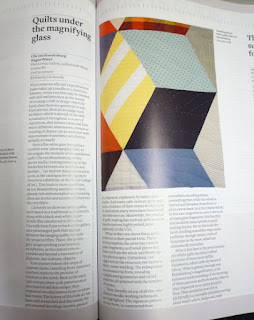 Too late to go see Ulla von Brandenburg's show of some super-size quilts, I read a review of it - a rather puzzling review - in Crafts magazine. There are photos of the installation online, on the gallery's website - click here.
Too late to go see Ulla von Brandenburg's show of some super-size quilts, I read a review of it - a rather puzzling review - in Crafts magazine. There are photos of the installation online, on the gallery's website - click here.Are these "quilts" - or artworks using quilt format? Do they exhibit the skill, the link with tradition, that some say is required in a quilt? Or are they the embodiment of an idea for which "the quilt block", with its associated three-layer stitching, is the best expressive medium? That a video (of grainy-grey images) is shown along with the quilts could be a factor... as is, apparently, the zig-zag path you take through the hanginging quilts towards the video.
Is the message that the lure of technology causes us to ignore the handmade? No, the official view (on the gallery website) is that it's about charting our path through obstacles.
"Your journey echoes the steps of runaway slaves," said the review; "these quilt patterns were developed to aid that escape." Well, there's been a lot of controversy about the Underground Railroad quilts; perhaps the artist has chosen to ignore it, and go with the romantic story - and why not?
A point that won't elude "real quilters" is the link that the big quilting stitches make with the Gee's Bend quilts.
But fabric is just one of the media Ulla von Brandenburg's work embraces, and knowing more about the artists makes a difference to understanding the exhibition. "Ulla von Brandenburg works with different media such as drawing, video, film, space installation and performance. Motives of historic originals are brought forward by the illustration in a current time context and therefore act as filters that switch between the illustration and the viewer" says this site; and here we can read that: "Von Brandenburg adapts the poses and gestures of these representations or perhaps a theatrical quality, which examines the relationship of appearance and reality in abstract manner. In so doing she is less interested in adopting existing content than in formal staging, which exposes a wealth of cultural and representational patterns of interpretation."
 Her "Curtain" (shown above at the Frieze art fair) was in the Tate's "The World as a Stage" exhibition in 2007 (another one I missed...). It's "a reconstruction of the patchwork curtain specially designed in 1932 for the Royal Shakespeare Theatre in Stratfordupon-Avon. A slight gap where the curtains meet in the middle heightens our sense of the divide between performers and audience, and raises the question: which side are we on?" Below is the way it was displayed at the Tate.
Her "Curtain" (shown above at the Frieze art fair) was in the Tate's "The World as a Stage" exhibition in 2007 (another one I missed...). It's "a reconstruction of the patchwork curtain specially designed in 1932 for the Royal Shakespeare Theatre in Stratfordupon-Avon. A slight gap where the curtains meet in the middle heightens our sense of the divide between performers and audience, and raises the question: which side are we on?" Below is the way it was displayed at the Tate.
No comments:
Post a Comment